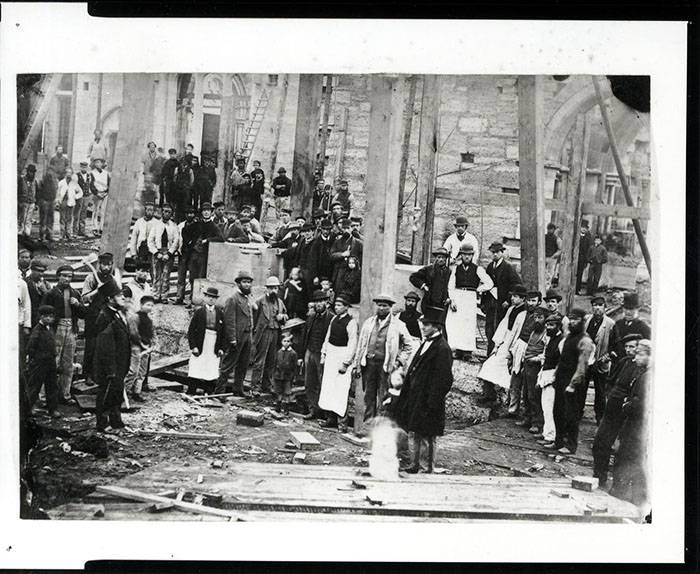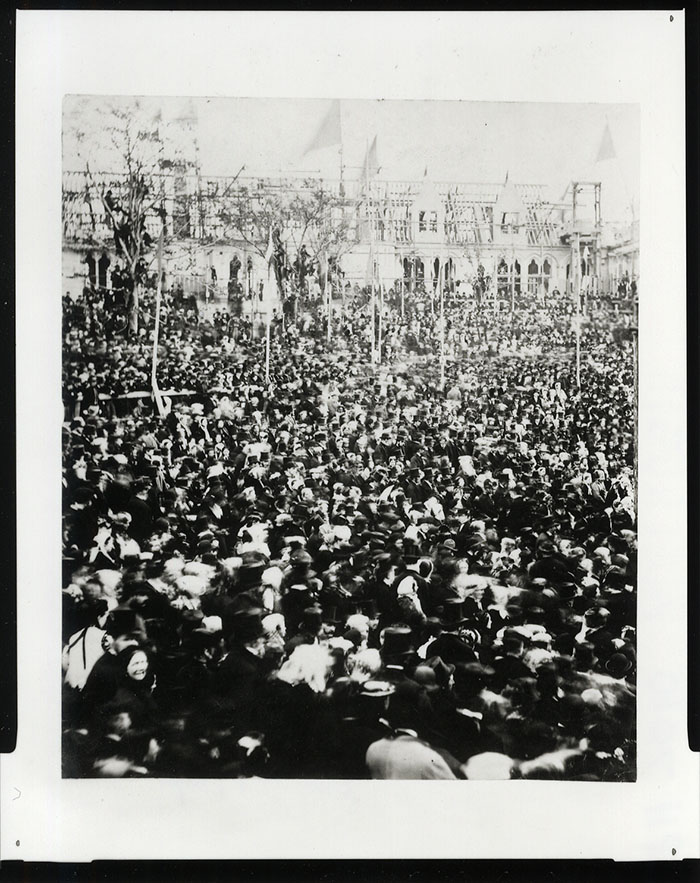Gilmorehill at 150
Published: 1 October 2018
Next week the University will mark 150 years since a foundation stone was laid at the Gilmorehill campus, symbolising its move from the city centre.
Next week is 150 years since the University laid a foundation stone at the site of the Gilbert Scott Building on Giilmorehill.
In this week’s newsletter Nick Haynes, author of ‘Building Knowledge: An Architectural History of the University of Glasgow’, tells the story behind the reasons for and the details of the move which shaped the University as we know it today.
Look out for more about the 150th anniversary of Gilmorehill in next week’s edition!
The University of Glasgow buildings – from the High Street to Gilmorehill
As Prince Edward and Princess Alexandra of Wales arrived in Glasgow on 8th October 1868 for the laying of the foundation stone at Gilmorehill, the University authorities unfurled a banner on their old High Street home: ‘Resurgat in Gloria’ (may it rise again in glory). 150 years later, George Gilbert Scott’s Gilmorehill complex is rightly celebrated as one of the great architectural glories of Scotland and the institution headquartered within it flourishes on the global stage.
The University had developed from the middle of the 15th century on a site in the High Street between the ancient ecclesiastical and commercial centres of the city. During the 17th century the University constructed a magnificent renaissance complex of two courtyards with a central tower. A particularly ornate range of 1659 faced the High Street, encrusted with tall chimneys, carved balconies, window pediments and dormerheads, and the royal arms.
Further distinguished buildings followed, including Alexander McGill’ s Professors’ Court (1723), William Adam’s Library (1732) and William Stark’s much-admired Hunterian Museum (1807). In spite of the University’s efforts to modernise the campus to meet the needs of increased numbers of students and new areas of study, the surrounding High Street declined into a polluted and disease-ridden slum by the early years of the 19th century. Soot blackened the buildings, stench from the nearby St Rollox Chemical Works enveloped the occupants, and there were frequent fatal outbreaks of cholera amongst the staff and students.
At the beginning of the railway age, the various railway companies jostled to find strategic sites in the city centre for a terminus. Glasgow, Airdrie & Monklands Junction Railway Company was the first to recognise the University’s High Street site as a potential location for a station in 1845. A site at Woodlands on the western edge of the city was identified for a new University complex. For various reasons the opportunity to move slipped away, but the principle of selling the High Street site to fund a new building on a suburban site had been established. Finally in 1864 the Union Railway Company offered £100,000 for the High Street site, enabling the University to submit bids for lands at Gilmorehill in the developing West End of the city.
To design their new home, the University selected the prolific Gothic Revival architect George Gilbert Scott, now best known for the Albert Memorial and the Midland Grand Hotel at St Pancras in London. Scott conceived the enormous project around two collegiate quadrangles in a Franco-Scots style of the 14th century. However medieval the appearance of the design, it incorporated up-to-the-minute technology in the form of structural iron girders, iron-framed windows, and modern heating, lighting and ventilation systems. Construction began in January 1867 on the largest building project to date in Scotland. By the end of the first phase of construction in 1877 the building had cost £427,856 and comprised more than a million cubic feet (28,317m2) of Gilmorehill stone, 1.9 million bricks, six acres (2.4 hectares) of timber flooring, 1,876 gas burners, and over 200 door locks.
Despite the railway company receipts, government grants and a global public appeal, a lack of money dogged the project. By November 1870, when the University first occupied parts of the Gilmorehill building, the funding was exhausted and the complex was far from finished. It was 1878 before Scott’s son, John Oldrid, began work on the Bute and Randolph Halls, and 1888 when he completed the crowning glory of the complex, the tower, to a new design. The Chapel followed after the First World War.
- Nick Haynes
‘Building Knowledge: An Architectural History of the University of Glasgow’ is available from the University shop.


First published: 1 October 2018

